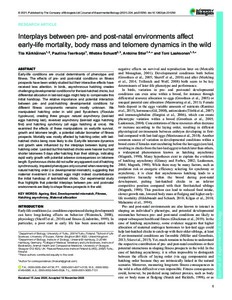Interplays between pre- and post-natal environments affect early-life mortality, body mass and telomere dynamics in the wild
Laaksonen Toni; Kärkkäinen Tiia; Stier Antoine; Teerikorpi Pauliina; Schuett Wiebke
https://urn.fi/URN:NBN:fi-fe2021042826030
Tiivistelmä
Early-life conditions are crucial determinants of phenotype and fitness. The effects of pre- and post-natal conditions on fitness prospects have been widely studied but their interactive effects have received less attention. In birds, asynchronous hatching creates challenging developmental conditions for the last-hatched chicks, but differential allocation in last-laid eggs might help to compensate this initial handicap. The relative importance and potential interaction between pre- and post-hatching developmental conditions for different fitness components remains mostly unknown. We manipulated hatching order in wild pied flycatchers (Ficedula hypoleuca), creating three groups: natural asynchrony (last-laid eggs hatching last), reversed asynchrony (last-laid eggs hatching first) and hatching synchrony (all eggs hatching at once). We examined the effects of these manipulations on early-life survival, growth and telomere length, a potential cellular biomarker of fitness prospects. Mortality was mostly affected by hatching order, with last-hatched chicks being more likely to die. Early-life telomere dynamics and growth were influenced by the interplays between laying and hatching order. Last-laid but first-hatched chicks were heavier but had shorter telomeres 5 days after hatching than their siblings, indicating rapid early growth with potential adverse consequences on telomere length. Synchronous chicks did not suffer any apparent cost of hatching synchronously. Impaired phenotypes only occurred when reversing the natural hatching order (i.e. developmental mismatch), suggesting that maternal investment in last-laid eggs might indeed counterbalance the initial handicap of last-hatched chicks. Our experimental study thus highlights that potential interplays between pre- and post-natal environments are likely to shape fitness prospects in the wild.
Kokoelmat
- Rinnakkaistallenteet [19218]
